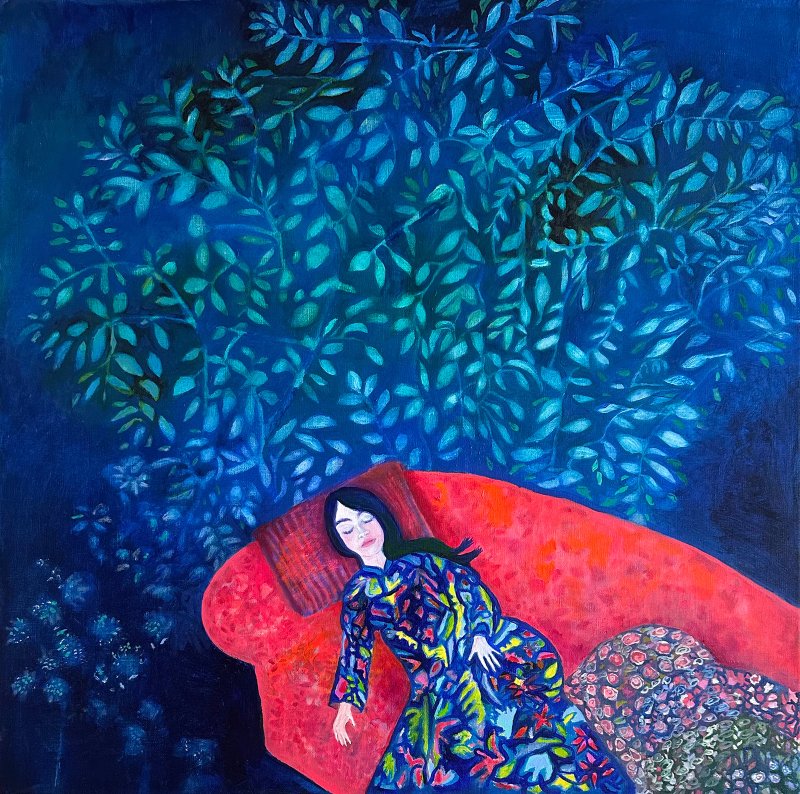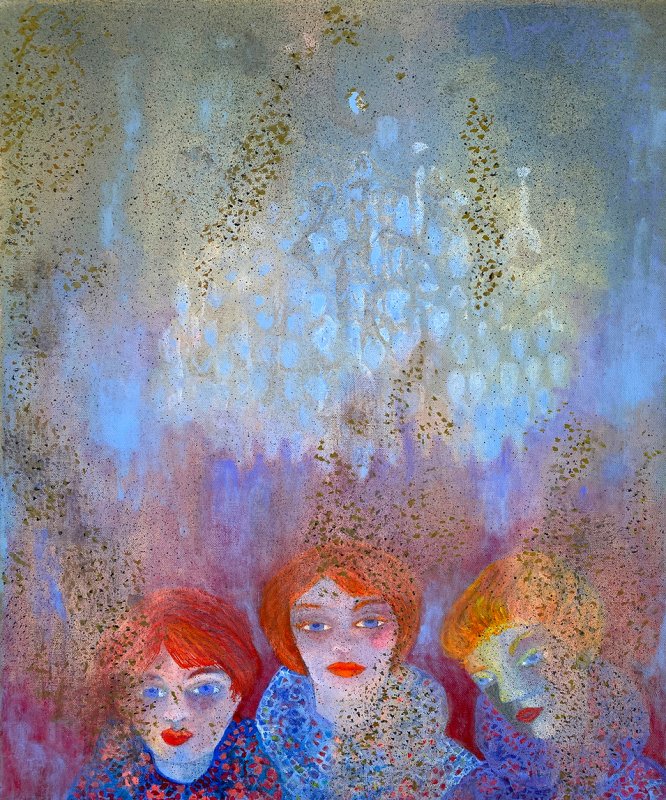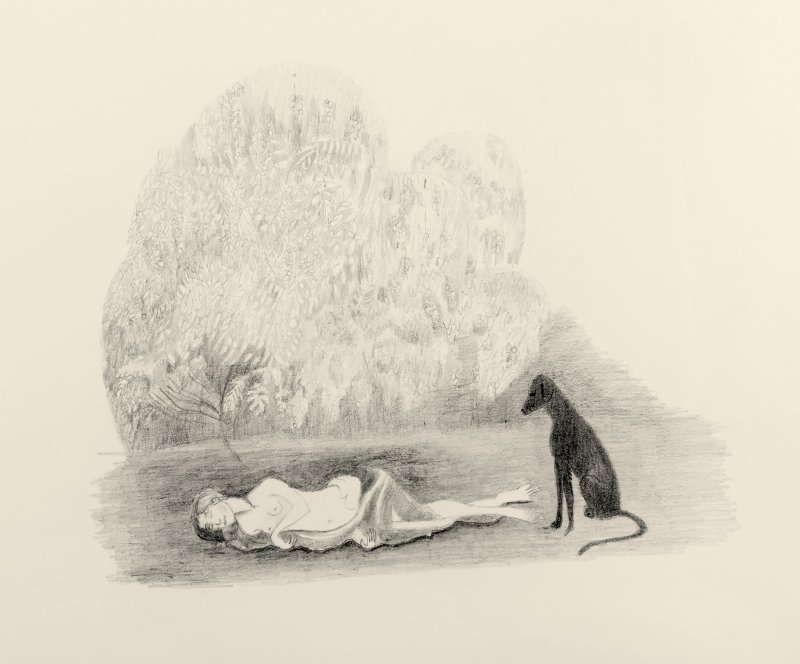Reviews and critical comment
Essay by Dr Roberta McGrath
'…there's no such thing as a grown up person' (Andre Malraux, Anti–Memoirs, 1968)
 Deft and light of touch, we can easily imagine the sound of the artist's sharpened pencil tip on a soft sheet of buttery-cream cartridge paper. There is rhythm here, gentle caresses and quick-witted lines for us to enjoy. Without the distraction of colour, tone and form take shape; a button, a heel on a shoe; a soft, wolf-grey wisp of a girl; a few men in solid, armour-like suits mingle amongst 'the women'. But there is also a suit-wearing woman here. Separated from the herd, her back turned, she looks at a painting of uncertain content alone. The others, exhibitionists and voyeurs – who have come to be looked at as much as to look – have made an exhibition of themselves. And here they are cut down to size, a picture at an exhibition.
Deft and light of touch, we can easily imagine the sound of the artist's sharpened pencil tip on a soft sheet of buttery-cream cartridge paper. There is rhythm here, gentle caresses and quick-witted lines for us to enjoy. Without the distraction of colour, tone and form take shape; a button, a heel on a shoe; a soft, wolf-grey wisp of a girl; a few men in solid, armour-like suits mingle amongst 'the women'. But there is also a suit-wearing woman here. Separated from the herd, her back turned, she looks at a painting of uncertain content alone. The others, exhibitionists and voyeurs – who have come to be looked at as much as to look – have made an exhibition of themselves. And here they are cut down to size, a picture at an exhibition.
These drawings are like tiny jewels, love letters and party invitations from the artist to join a miniature and minutely observed world of magical, doll-like figures or circus animals (where pigs do indeed fly). It is a world of fun. And yet, as in all fairy tales, there is a dark side too. There is a sense that the crocodiles are not far behind us – or perhaps ahead of us, or even dangerously beneath our feet. They are, in fact, everywhere lying in wait to snap at our ankles. Chop-chop, and the feet are gone. As in Hans Andersen's magnificent tale The Red Shoes (and oh! the shoes, the fabulous shoes in Roper's drawings – to say nothing of the frocks and fabrics) we must all perform and make something of our lives until the final curtain drops. But whether sooner, or later, we all fall down. Once upon a time will inevitably become The End. In the meantime for Roper the angel is in her love of detail. The drawings are wistful, and mischievous too, as if something of the artist as a small girl remains.
The child of course lives in a rich tapestry where fantasy and reality are intricately interwoven – and where fantasy still has the power to trump reality. This is a world of play, and it is this imaginative world that artists also inhabit. In Roper's work such a world is only a hop, skip and a jump away and both restlessness and calm haunts the larger paintings. There is a sense here of figures that on the move, somewhere between where they have come from, or are going to, neither children nor quite adults. While we cannot go back, neither can we ever fully go forward. Grown women are stuffed under tables. They may be playing (or then again, maybe not). These scenes are often of domestic interiors, ambiguous places of both warm, and sometimes cold, comfort. In Roper's dreamlike painting washes of cobalt and ultramarine blues, verdant and leafy greens, toffee apple reds, gamboge and cadmium yellows – an entire liturgy of sensuous colour – beckons, inviting us into a luminous and enchanted world somewhere between reality and fantasy. There are chequered floors (and lives), and outside there are seas and rivers and boats of escape that carry the lovers – but to where? In the game of hide and seek it is never really clear who is hiding and who is seeking. The subjects are to all intents and purposes lost to each other. One can imagine a commandment: Hide and ye shall seek; Seek and ye shall hide. We remain mysteries not only to others, but also to ourselves. Hide as much as you want and you will be found out. Seek all you want and there will still be something hidden.
Psychoanalysis teaches us that the unconscious changes very little over time and therefore largely remains the repository of infantile wishes and desires (hence the priest's conclusion in Malraux's Anti–Memoirs). These are simple things, the very stuff of life, where murderous intent co-exists with a love supreme: I HATE you; I want to kill you or I LOVE you; I could eat you up. There is something here of the Garden of Eden after the Fall, especially in the paintings, with their reflective mirrors and figures covering their eyes so that they may not directly see the naked truth (or the Gorgon's stare?). But of course just like the child we must look, in spite of everything we know as adults, and every single day to be in the world means risking being expelled or devoured – part or whole. Roper reminds us that after all the shenanigans, the fun, the games, the bread and circuses of life with its pleasures and its pains, we are human. And of course this also means there is indeed no such thing as a grown-up person.
Dr Roberta Wilson McGrath, Reader in Photographic History, Theory and Criticism, School of Arts and Creative Industries, Edinburgh Napier University
Peter Suchin on the Paintings
In the Exhibition Catalogue for ‘Fable and Fantasy’ (six realists of the unreal, Adrienne Craddock, Elisabeth Frink, Karolina Larusdottir, Ana Maria Pacheco, Paula Rego and Gerda Roper) Peter Suchin, Critic in Residence for the 1996 Year of the Visual Arts wrote the following excerpts:
 “The work of the artists collected together here ultimately coheres as a series of approaches to what one might term ‘unreal realism’, a selection of ways of picturing the world from the points of view of the fabulous, the mythical, the near-surreal or fantastic.
“The work of the artists collected together here ultimately coheres as a series of approaches to what one might term ‘unreal realism’, a selection of ways of picturing the world from the points of view of the fabulous, the mythical, the near-surreal or fantastic.
“It is not my intention here to reduce such a diversity to a few formulaic traits, restricting what is plural to a few neat strategies of artistic practice. I propose, rather, to give some suggestions – and they are only that – as to how the numerous works in this display might be productively read.
“Sometimes a pretty, sleek or sweet surface can deceive. Gerda Roper’s muted colours and dissolving compositions are palimpsests of deception in ways that only a close inspection might uncover. Scintillating splashes and patches of paint that may at first glance appear to develop into pleasant reveries, seeming daydreams, are in fact the medium in which an altogether darker reflexive texture is held. Titles act as clues to guide the viewer towards these deeper themes. These works operate at the fringe of the figurative. Mallarme’s remark that one should ‘paint not the thing but the effect it produces’ comes to mind.”
Peter Suchin, Critic in Residence for the 1996 Year of the Visual Arts
Howard Burch on the Drawings
“What sticks in my memory about your drawings is that they were like delicate vignettes. Reflections, remembrances – fleeting, tiny (literally) and delicate. Intricate but fragile. Almost as if you breathed on them they would blow away.
 “I loved the fact that they were so effortlessly wrought at times – the rubbings out and the painstakingly fine, delicate detail – and at others clearly spontaneous. The figures appearing to be placed so randomly, off-kilter on the big sheets. Demanding that you look closer, closely at them. Details, part of a bigger picture, perhaps?
“I loved the fact that they were so effortlessly wrought at times – the rubbings out and the painstakingly fine, delicate detail – and at others clearly spontaneous. The figures appearing to be placed so randomly, off-kilter on the big sheets. Demanding that you look closer, closely at them. Details, part of a bigger picture, perhaps?
“I remember the figures were sometimes twisted and bent like ballet dancers – fine and posed. Others awkward and ill at ease. Most were happy, at peace.
“These were the pleasures of life, small and everyday – and yet important memories, the very stuff of life itself, that we keep carrying around everyday in our heads. Your art exists there now too.
“I thought they were really lovely.”
Howard Burch, Head of Drama, Keshet International (also producer of TV drama series including Loaded, Hustle, Spooks, Ashes to Ashes, Moving Wallpaper, Echo Beach)